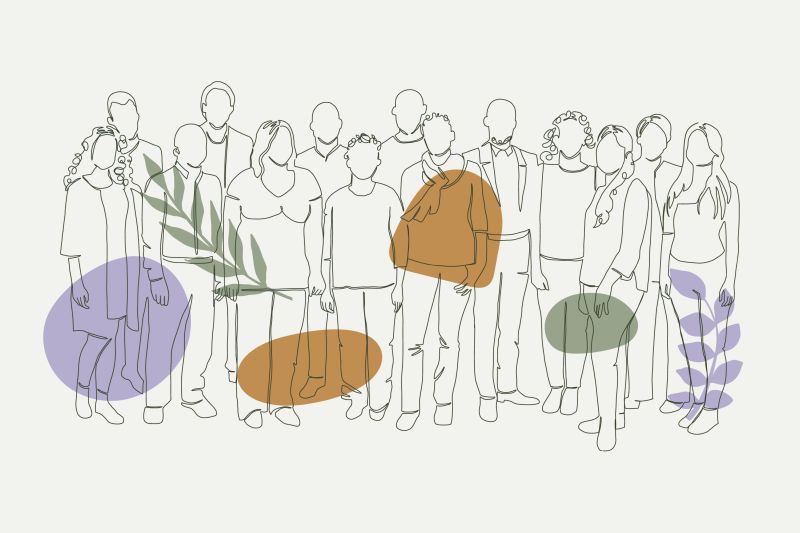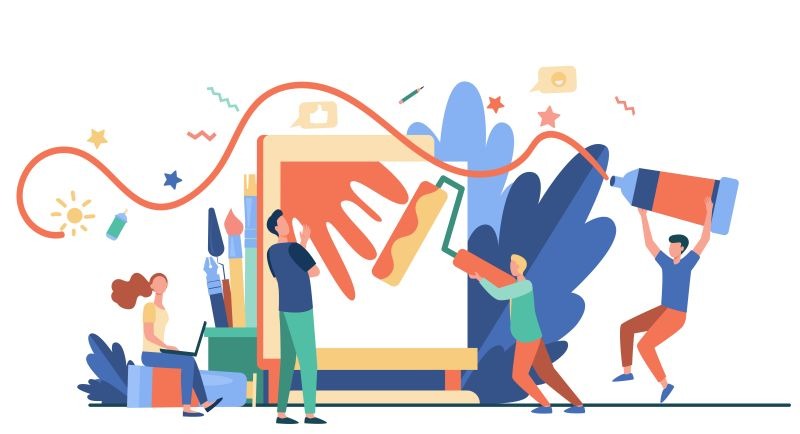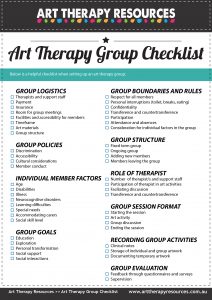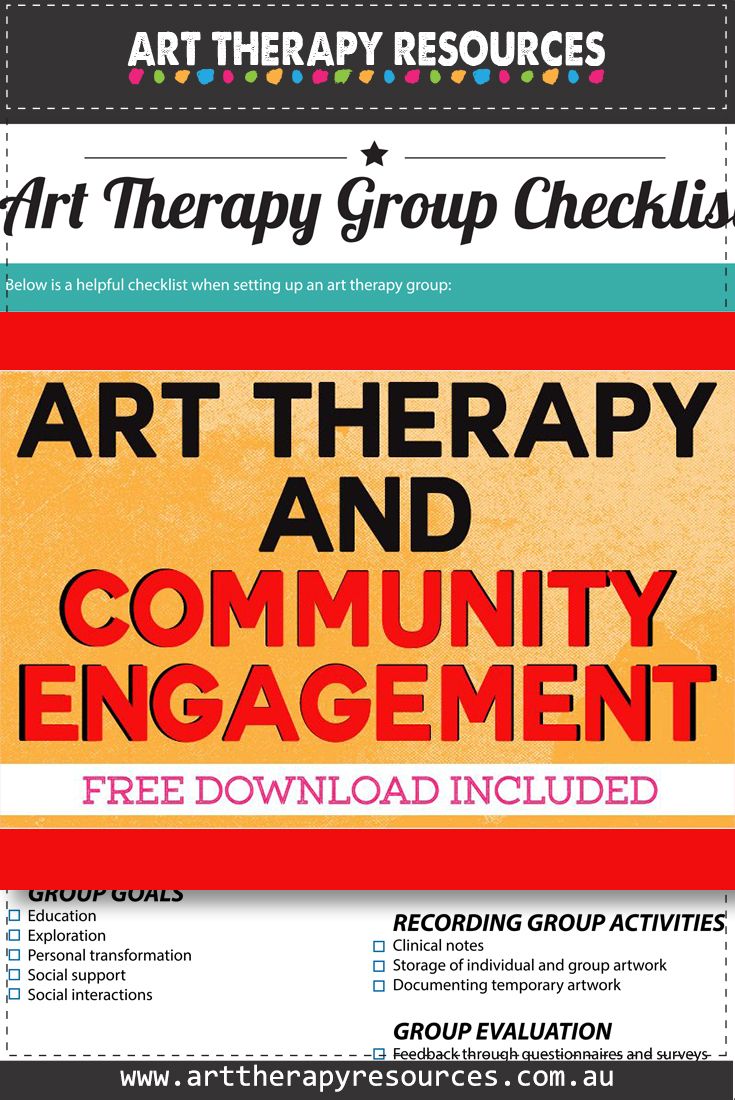THIS POST INCLUDES:
1. Embracing Community
2. Fostering Inclusive Spaces
3. Tailoring Programs to Community Needs
4. Free Download Art Therapy Group Checklist
EMBRACING COMMUNITY

Art therapy is a dynamic form of psychotherapy that can play an integral part in developing connections within the community. The expression and appreciation of art itself is universally understood by most people. In this context, art can be used as a conduit to help connect communities through creative expression and sharing creative ideas.
Additionally, for art therapists aspiring to build a successful private practice, understanding the significance of community issues is vital to understanding what the needs are within the community that you wish to work within. Community also plays an integral role in art therapy where new ideas can be shared and built upon within the art therapy community.
An important part of working within the community is understanding where people meet and engage in activities that might support your art therapy work. You may already have allied health contacts that can help you make community connections with those who require mental health support, however, there are also organisations and associations that are well established in the community that can assist you in developing programs to their specific community group.
Engaging with Local Art Galleries and Community Centers
If you have already developed an art therapy program that can serve the needs of the community, then you may need to access space to deliver these programs. Utilizing community spaces for art therapy group sessions can help you extend the reach of your art therapy practice.
Engaging with local art galleries, community centers, or even public spaces can provide art therapists with a platform to connect with a broader audience. This not only enriches the community but also fosters collaboration between the art therapist and local entities. This can help you achieve short term goals of delivering community programs, however, more importantly, it helps you build ongoing networks for future opportunities that may arise within other local entities.
Art therapists should communicate their commitment to the wellbeing of their community and emphasize the positive impact of art therapy on individuals and the collective community group. When developing marketing materials to advertise any community programs, ensure that you are emphasizing the connection of community and your program’s purpose to any potential clients.
To excel in community-based art therapy, ongoing professional development is crucial. Art therapists should seek training and resources that enhance their understanding of community dynamics, cultural competence, and effective strategies for engagement. Staying informed and updated allows therapists to adapt to the evolving needs of the community.
FOSTERING INCLUSIVE SPACES THROUGH ART

Celebrating Diversity in Creative Expression
In community-centric art therapy, diversity becomes an integral part of helping to foster a sense of community and acceptance amongst all demographics. Art can act as a conduit to bring groups together and work on collaborative goals. Art sessions become platforms where individuals from diverse backgrounds can express themselves authentically. This celebration of diversity not only enriches the therapeutic experience but also fosters a sense of inclusivity within the community.
The celebration of diversity enhances the therapeutic experience by acknowledging the unique healing journeys of individuals from varied backgrounds. Therapists can embrace a multitude of perspectives and tailor interventions to honor the cultural nuances that shape each person’s relationship with art.
Community-centric art therapy can be an important introductory experience to creativity as well as mental health awareness within a community.
Building Bridges Through Collaborative Art Projects
Collaborative art projects serve as bridges, connecting individuals within a community. Through shared artistic endeavors, art therapists can facilitate the creation of a collective narrative. This not only strengthens social bonds but also creates a tangible representation of community unity through art.
Art therapists act as facilitators, guiding the community in the creation of a collective narrative. Each participant becomes a storyteller, contributing their unique perspectives to the overarching narrative.
Collaborative projects allow for the weaving of stories that reflect the collective experiences, aspirations, and challenges of the community. Art becomes the language through which the community expresses its shared identity.
The finished collaborative artwork serves as a tangible symbol of unity. It becomes a visual representation of the interconnectedness and collaboration that define the community. Collaborative art projects contribute to the emotional well-being of participants. The shared creative process fosters a sense of belonging, offering emotional support to individuals within the community.
Healing Collectively: Art Therapy for Community Trauma
In the face of shared challenges and traumas, communities often seek avenues for collective healing. Art therapy emerges as a powerful tool, providing a safe and expressive space for individuals and communities to navigate and overcome adversity. Art therapists play a pivotal role in guiding the collective journey, fostering resilience, and addressing shared experiences for the betterment of communal well-being.
Art therapy serves as a therapeutic sanctuary where individuals within a community can freely express their emotions and experiences. The safe space encourages open dialogue and the sharing of collective burdens.
Trauma often carries a weight of silence within communities. Art therapy breaks this silence by providing a non-verbal outlet for expression. Participants can communicate complex emotions and experiences through artistic mediums.
Art therapy fosters connection by acknowledging shared experiences within the community. Group activities provide a platform for individuals to connect with others who have faced similar challenges.
Art therapists assist in constructing a communal narrative that acknowledges the collective journey of overcoming adversity. Through collaborative art projects, communities weave a tapestry of shared strength and solidarity.
TAILORING PROGRAMS TO COMMUNITY NEEDS
Art therapists serve diverse populations, each embedded in its own socio-cultural fabric. By delving into the dynamics of the community, therapists gain insights into its values, traditions, and collective experiences. This understanding is fundamental for crafting interventions that honor and acknowledge the community’s unique identity.
1. CULTURAL REPRESENTATION
– Examine the cultural tapestry of the community, recognizing the significance of traditions, rituals, and customs.
– Incorporate elements that respect and celebrate the diversity within the community, ensuring interventions are culturally sensitive and inclusive.
2. SOCIO-ECONOMIC FACTORS
– Explore the socio-economic landscape to identify potential barriers or disparities that may impact accessibility to art therapy services.
– Tailor interventions to address specific social and economic challenges, fostering a more inclusive and equitable therapeutic environment.
3. COMMUNITY HISTORY
– Investigate the historical narrative of the community, recognizing pivotal events that may have shaped collective experiences.
– Design interventions that acknowledge historical contexts, allowing for a nuanced and empathetic approach to therapeutic engagement.
– With an understanding of the community dynamics, art therapists can tailor interventions that resonate authentically with the individuals they serve.
4. CUSTOMIZING THERAPEUTIC APPROACHES
– Adapt art therapy techniques to align with the cultural preferences and demographics that are prevalent in the community.
– encourage cultural expression including culturally relevant symbols and artistic traditions into therapeutic activities for a more personalized and meaningful experience.
5. BUILD TRUST AND RAPPORT
– Establishing trust is paramount. Craft interventions that reflect an understanding of the community’s values, fostering a sense of trust and safety.
– Foster rapport by acknowledging and respecting the community’s unique strengths, resilience, and coping mechanisms.
6. COLLABORATIVE PROGRAM DEVELOPMENT
– Involve community members in the planning and development of art therapy programs. Their insights and perspectives are invaluable in shaping interventions that truly resonate.
– Foster a collaborative approach, ensuring that the community feels a sense of ownership and empowerment in the therapeutic process.
7. ADDRESS COMMUNITY SPECIFIC STRESSORS
– Identify stressors prevalent in the community, whether they be related to environmental factors, economic challenges, or interpersonal dynamics.
– Tailor interventions to directly address and alleviate these stressors, providing a holistic and targeted therapeutic experience.
8. PROMOTE RESILIENCE AND COPING SKILLS
– Recognize and highlight the community’s inherent strengths and resilience.
– Design interventions that enhance coping mechanisms specific to the challenges faced by the community, promoting long-term emotional well-being.
9. ENCOURAGE FEEDBACK
– Implement robust feedback mechanisms to continuously evaluate the effectiveness of interventions.
– Adapt programs based on ongoing feedback, ensuring that therapeutic approaches remain responsive to the evolving needs and aspirations of the community.
Assessing community needs is not just a preliminary step but an ongoing commitment to understanding, respecting, and evolving with the community. By tailoring art therapy interventions to the specific nuances of each community, art therapists can forge deeper connections and facilitate programs that make a lasting impact.
FREE DOWNLOAD: Art Therapy Exercise

BUILD YOUR ART THERAPY REFERENCE MATERIALS:
Pin this image to your Pinterest board.

SHARE KNOWLEDGE & PASS IT ON:
If you’ve enjoyed this post, please share it on Facebook, Twitter, Pinterest. Thank you!
